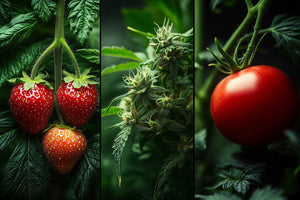Have you ever wondered, “Do my succulents, tomatoes, or even that plant I’ve been nurturing need a dedicated grow lamp?”
The answer is clear—yes, they do.
Each plant has its unique light requirements, just like people prefer different living environments. Today, let's discuss how to choose the most suitable grow lamp for different types of plants.
1. What Kind of Light Do Plants Need?
Plants can be quite “picky”; not just any light will help them thrive. Blue and red lights are particularly important for plants. Blue light promotes chlorophyll production and helps plants grow stems and leaves.
And red light? It’s the key player for flowering and fruiting.
So, how do you choose the right light source for different plants? Keep reading to find out.
2. Types of Grow Lamps for Plants
Currently, there are three main types of grow lamps on the market: LED lamps, HPS lamps, and fluorescent lamps.

-
LED Grow Lights: These are the “jack-of-all-trades” of grow lamps. They provide a broad spectrum of light, have low heat output, long lifespan, and are suitable for all growth stages of various plants. If you want something efficient and low-maintenance, LED lights are your best bet.
-
HPS Lamps: These lights are extremely intense, making them ideal for the flowering stage of plants. However, they have drawbacks—high heat output and energy consumption.
-
Fluorescent Lamps: Suitable for small plants and seedlings, they provide gentle light and are particularly good for plants with low light requirements.
3. Plant Requirements

1). Leafy Vegetables
For leafy vegetables like lettuce, spinach, and kale, light requirements are mainly concentrated in the red and blue spectrum. Blue light (400-500 nm) aids in leaf expansion and enhances photosynthesis, making the plants sturdier. Red light (600-700 nm) promotes stem growth and speeds up overall development.
These plants can benefit from red-blue LED grow lights, typically with a red-to-blue ratio of 4:1, which is ideal for plant growth.
They generally need 12 to 16 hours of adequate light per day with moderate intensity (usually between 200-400 μmol/m²/s).
2). Succulent Plants
Succulents, like cacti and other fleshy plants, need at least 4 hours of sufficient light daily. You can opt for full spectrum LED lights, which closely mimic natural sunlight.
3). Cannabis Plants
Cannabis is particularly sensitive to light and thrives under full spectrum LED lights, providing a PAR range of 400-700 nm. This ensures every growth stage receives ample light.
- Vegetative Stage: Maintain 18 hours of light and 6 hours of darkness.
- Flowering Stage: Switch to 12 hours of light and 12 hours of darkness.
Recommended Product:
Conclusion
Different plants have varying light needs, and using the wrong lamp could leave your plants struggling. For healthy growth, scientific lighting is essential. I hope this guide helps you find the perfect “sunlight” for your green companions.

